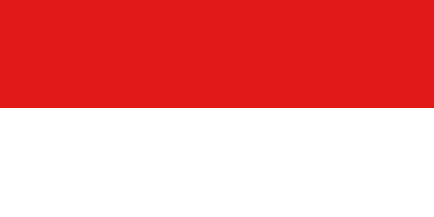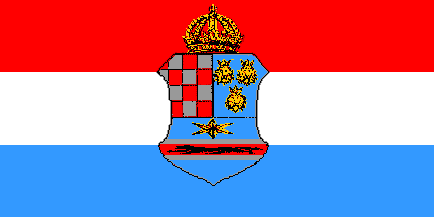
Flags of Croatia
Encyclopedia
This is a list of flags which have been, or are still today, used in Croatia
or by Croats
.
For more information on main flags see article: Flag of Croatia
Croatia
Croatia , officially the Republic of Croatia , is a unitary democratic parliamentary republic in Europe at the crossroads of the Mitteleuropa, the Balkans, and the Mediterranean. Its capital and largest city is Zagreb. The country is divided into 20 counties and the city of Zagreb. Croatia covers ...
or by Croats
Croats
Croats are a South Slavic ethnic group mostly living in Croatia, Bosnia and Herzegovina and nearby countries. There are around 4 million Croats living inside Croatia and up to 4.5 million throughout the rest of the world. Responding to political, social and economic pressure, many Croats have...
.
For more information on main flags see article: Flag of Croatia
Flag of Croatia
The flag of Croatia is one of the state symbols of Croatia. It consists of three equal size, horizontal stripes in colours red, white and blue. The flag combines the colours of the flags of the Kingdom of Croatia , the Kingdom of Slavonia and the Kingdom of Dalmatia...
National and State flag
| Flag | |Use | Flag of Croatia Flag of Croatia The flag of Croatia is one of the state symbols of Croatia. It consists of three equal size, horizontal stripes in colours red, white and blue. The flag combines the colours of the flags of the Kingdom of Croatia , the Kingdom of Slavonia and the Kingdom of Dalmatia... | Three equal horizontal fields, red on the top, white in the middle and blue on the bottom, Coat of Arms Coat of arms of Croatia The coat of arms of Croatia consists of one main shield and five smaller shields which form a crown over the main shield. The main coat of arms is a checkerboard that consists of 13 red and 12 silver fields. It's commonly known as šahovnica or grb... in the center. |
|---|---|---|---|
Standard of the President of the Republic
| Flag | |Use | President of Croatia President of Croatia The President of Croatia , officially styled the President of the Republic represents the Republic of Croatia in the country and abroad as the head of state, maintains the regular and coordinated operation and stability of the national government system, and safeguards the independence and... | Standard of the President of Croatia |
|---|
Naval flags
| Flag | |Use | ||
|---|---|---|---|
| Flag | |Use | Republic of Croatia Socialist Republic of Croatia Socialist Republic of Croatia was a sovereign constituent country of the second Yugoslavia. It came to existence during World War II, becoming a socialist state after the war, and was also renamed four times in its existence . It was the second largest republic in Yugoslavia by territory and... (federal unit of Yugoslavia Socialist Federal Republic of Yugoslavia The Socialist Federal Republic of Yugoslavia was the Yugoslav state that existed from the abolition of the Yugoslav monarchy until it was dissolved in 1992 amid the Yugoslav Wars. It was a socialist state and a federation made up of six socialist republics: Bosnia and Herzegovina, Croatia,... ). In official use June 27 - December 21, 1990. | Three equal horizontal fields, red on the top, white in the middle and blue on the bottom, Coat of arms of Croatia in the center of the middle field. The first field of the coat of arms was never specified in the Croatian constitution. The flag used Republic of Croatia colors, proportions 1:2. |
 |
June 2, 1945 – June 27, 1990 | Flag of Socialist Republic of Croatia Socialist Republic of Croatia Socialist Republic of Croatia was a sovereign constituent country of the second Yugoslavia. It came to existence during World War II, becoming a socialist state after the war, and was also renamed four times in its existence . It was the second largest republic in Yugoslavia by territory and... (subdivision of SFR Yugoslavia). |
A tricolour of red, white, and blue with a (golden-rimmed) red star in the center. The flag used Yugoslav colors, proportions 1:2. |
| December 15, 1943 – June 2, 1945 | Flag of the Federal State of Croatia (subdivision of DF Yugoslavia), used during World War II. | A tricolour of red, white, and blue with a red star in the center of middle field. The flag used Yugoslav colors, proportions 1:2. |
|
| October 9, 1941 – March 25, 1942 | "Flag of Croatian-Serbian friendship", an early flag of the Yugoslav Partisan movement | Early flag of the Yugoslav Partisan movement, divided (left half Croat, right half Serb flag). The flag used Yugoslav colors, proportions 2:3. |
|
| November 21, 1939 – October 17, 1943 (January 21, 1941) | Flag of the Banovina of Croatia Banovina of Croatia The Banovina of Croatia or Banate of Croatia was a province of the Kingdom of Yugoslavia between 1939 and 1943 . Its capital was at Zagreb and it included most of present-day Croatia along with portions of Bosnia and Herzegovina and Serbia... (subdivision of the Kingdom of Yugoslavia Kingdom of Yugoslavia The Kingdom of Yugoslavia was a state stretching from the Western Balkans to Central Europe which existed during the often-tumultuous interwar era of 1918–1941... ). Used de facto 1939-1941; legally valid 1939-1943. |
A tricolour of red, white, and blue. The flag used Yugoslav colors, proportions 2:3. |
|
 |
1918 | Flag of State of Slovenes, Croats and Serbs State of Slovenes, Croats and Serbs The State of Slovenes, Croats and Serbs was a short-lived state formed from the southernmost parts of the Austro-Hungarian monarchy after its dissolution at the end of the World War I by the resident population of Slovenes, Croats, and Serbs... |
A tricolour of red, white, and blue. The flag used Yugoslav colors, proportions 1:2. |
 |
1860 – 1918 | Flag of the Kingdom of Croatia-Slavonia Kingdom of Croatia-Slavonia The Kingdom of Croatia-Slavonia or Croatia Slavonia was an autonomous kingdom within the Austro-Hungarian Empire. It was part of the Hungarian Kingdom within the dual Austro-Hungarian state, being within the Lands of the Crown of St. Stephen or Transleithania... (subdivision of the Austro-Hungarian Empire). Official on all levels. |
A tricolour of red, white, and blue. The flag used Croatian colors, proportions 2:3. |
 |
March 8, 1852 – 1860 | Flag of the Kingdom of Croatia Kingdom of Croatia (Habsburg) The Kingdom of Croatia was an administrative division that existed between 1527 and 1868 within the Habsburg Monarchy . The Kingdom was a part of the Lands of the Crown of St. Stephen, but was subject to direct Imperial Austrian rule for significant periods of time, including its final years... (subdivision of the Austrian Empire Austrian Empire The Austrian Empire was a modern era successor empire, which was centered on what is today's Austria and which officially lasted from 1804 to 1867. It was followed by the Empire of Austria-Hungary, whose proclamation was a diplomatic move that elevated Hungary's status within the Austrian Empire... ). Official on all levels. |
Two bars of red and white. The flag used Croatian colors, proportions 1:2. |
 |
1848 – 1852 | Flag of the Kingdom of Croatia Kingdom of Croatia (Habsburg) The Kingdom of Croatia was an administrative division that existed between 1527 and 1868 within the Habsburg Monarchy . The Kingdom was a part of the Lands of the Crown of St. Stephen, but was subject to direct Imperial Austrian rule for significant periods of time, including its final years... (subdivision of the Austrian Empire Austrian Empire The Austrian Empire was a modern era successor empire, which was centered on what is today's Austria and which officially lasted from 1804 to 1867. It was followed by the Empire of Austria-Hungary, whose proclamation was a diplomatic move that elevated Hungary's status within the Austrian Empire... ). Not used on the level of the Austrian Empire Austrian Empire The Austrian Empire was a modern era successor empire, which was centered on what is today's Austria and which officially lasted from 1804 to 1867. It was followed by the Empire of Austria-Hungary, whose proclamation was a diplomatic move that elevated Hungary's status within the Austrian Empire... . |
A tricolour of red, white, and blue with the triune coat of arms in the center. The flag used Croatian colors, proportions 1:2. |
 |
early 19th century – 1848 | Unofficial flag of the Kingdom of Croatia Kingdom of Croatia (Habsburg) The Kingdom of Croatia was an administrative division that existed between 1527 and 1868 within the Habsburg Monarchy . The Kingdom was a part of the Lands of the Crown of St. Stephen, but was subject to direct Imperial Austrian rule for significant periods of time, including its final years... (which at the time incorporated the subordinate Kingdom of Slavonia Kingdom of Slavonia The Kingdom of Slavonia was a province of the Habsburg Monarchy and the Austrian Empire that existed from 1699 to 1868. The province included northern parts of present-day regions of Slavonia and Syrmia... ) within the Austrian Empire Austrian Empire The Austrian Empire was a modern era successor empire, which was centered on what is today's Austria and which officially lasted from 1804 to 1867. It was followed by the Empire of Austria-Hungary, whose proclamation was a diplomatic move that elevated Hungary's status within the Austrian Empire... |
A tricolour of red, white, and blue. |
Independent State of Croatia
| Flag | |Use | Independent State of Croatia Independent State of Croatia The Independent State of Croatia was a World War II puppet state of Nazi Germany, established on a part of Axis-occupied Yugoslavia. The NDH was founded on 10 April 1941, after the invasion of Yugoslavia by the Axis powers. All of Bosnia and Herzegovina was annexed to NDH, together with some parts... (NDH). In use in Axis-occupied Croatia 1941-1945 (n.b. Nota Bene Nota bene is an Italian and Latin phrase meaning "note well". The phrase first appeared in writing circa 1721.Often abbreviated as "N. B.", nota bene comes from the Latin roots notāre and bene . It is in the singular imperative mood, instructing one individual to note well the matter at hand... illegal). | A tricolour of red, white, and blue with the Ustaše Ustaše The Ustaša - Croatian Revolutionary Movement was a Croatian fascist anti-Yugoslav separatist movement. The ideology of the movement was a blend of fascism, Nazism, and Croatian nationalism. The Ustaše supported the creation of a Greater Croatia that would span to the River Drina and to the border... symbol in top-left corner (letter "U" surrounded by Croatian wattle Croatian wattle The Croatian wattle, known as the pleter or troplet in Croatian, is a type of interlace, most characteristic for its three-ribbon pattern. It is one of the most often used patterns of pre-romanesque Croatian art... ) and the Croatian coat of arms (but with the first field white, as opposed to red) in the center. The flag used Ustaše Ustaše The Ustaša - Croatian Revolutionary Movement was a Croatian fascist anti-Yugoslav separatist movement. The ideology of the movement was a blend of fascism, Nazism, and Croatian nationalism. The Ustaše supported the creation of a Greater Croatia that would span to the River Drina and to the border... colors, proportions 2:3. |
|---|---|---|---|
| April 30, 1941 – May 7, 1945 | War flag of the Independent State of Croatia Independent State of Croatia The Independent State of Croatia was a World War II puppet state of Nazi Germany, established on a part of Axis-occupied Yugoslavia. The NDH was founded on 10 April 1941, after the invasion of Yugoslavia by the Axis powers. All of Bosnia and Herzegovina was annexed to NDH, together with some parts... (NDH). In use in Axis-occupied Croatia 1941-1945 (n.b. Nota Bene Nota bene is an Italian and Latin phrase meaning "note well". The phrase first appeared in writing circa 1721.Often abbreviated as "N. B.", nota bene comes from the Latin roots notāre and bene . It is in the singular imperative mood, instructing one individual to note well the matter at hand... illegal). |
A tricolour of red, white, and blue and the NDH coat of arms. The flag used Ustaše Ustaše The Ustaša - Croatian Revolutionary Movement was a Croatian fascist anti-Yugoslav separatist movement. The ideology of the movement was a blend of fascism, Nazism, and Croatian nationalism. The Ustaše supported the creation of a Greater Croatia that would span to the River Drina and to the border... colors, proportions 2:3. |
|
 |
1941–1945 | Standard of the Poglavnik Poglavnik Poglavnik was the title used by Ante Pavelić, leader of World War II Croatian fascist movement Ustaše and of the Independent State of Croatia between 1941 and 1945.-Etymology and usage:... of the Independent State of Croatia Independent State of Croatia The Independent State of Croatia was a World War II puppet state of Nazi Germany, established on a part of Axis-occupied Yugoslavia. The NDH was founded on 10 April 1941, after the invasion of Yugoslavia by the Axis powers. All of Bosnia and Herzegovina was annexed to NDH, together with some parts... |
Standard of the Poglavnik of the Independent State of Croatia Independent State of Croatia The Independent State of Croatia was a World War II puppet state of Nazi Germany, established on a part of Axis-occupied Yugoslavia. The NDH was founded on 10 April 1941, after the invasion of Yugoslavia by the Axis powers. All of Bosnia and Herzegovina was annexed to NDH, together with some parts... . |
 |
1941 - 1944/1945 | Naval Ensign of the Independent State of Croatia 1941 (from 1944 Naval Jack). | 2:3 squares 5×5 (total ratio 2:3) |
 |
1944–1945 | Naval Jack of the Independent State of Croatia 1944 (up to 1944 Naval Ensign variant). | 2:3 squares 5×5 (total ratio 2:3) |
| 1941–1945 | Flag of the Air Force of the Independent State of Croatia. | ||
| 1941–1945 | Flag of Minister of Armed Forces in Independent State of Croatia. | ||
| 1941–1945 | Flag of Minister in Independent State of Croatia. | ||
| 1941–1945 | Flag of Vojskovodja (Marchal) in Independent State of Croatia. | ||
| 1941–1945 | Flag of Commander of the Armed Forces in Independent State of Croatia. | ||
| 1941–1945 | Flag of Admiral in Independent State of Croatia. | ||
| 1941–1945 | Flag of Vice-admiral in Independent State of Croatia. | ||
| 1941–1945 | Flag of Rear Admiral in Independent State of Croatia. | ||
| 1941–1945 | Flag of General of the infantry, artillery, etc. in Independent State of Croatia. | ||
| 1941–1945 | Flag of Lieutenant General in Independent State of Croatia. | ||
| 1941–1945 | Flag of General in Independent State of Croatia. |
Historical regional flags
| Flag | |Use | Dalmatia Dalmatia Dalmatia is a historical region on the eastern coast of the Adriatic Sea. It stretches from the island of Rab in the northwest to the Bay of Kotor in the southeast. The hinterland, the Dalmatian Zagora, ranges from fifty kilometers in width in the north to just a few kilometers in the south.... , established as the flag of the Kingdom of Dalmatia Kingdom of Dalmatia The Kingdom of Dalmatia was an administrative division of the Habsburg Monarchy from 1815 to 1918. Its capital was Zadar.-History:... . In official use 1820-1918. | Two horizontal bars of blue and gold. Proportions 1:2. |
|---|---|---|---|
 |
Flag of the Kingdom of Slavonia Kingdom of Slavonia The Kingdom of Slavonia was a province of the Habsburg Monarchy and the Austrian Empire that existed from 1699 to 1868. The province included northern parts of present-day regions of Slavonia and Syrmia... |
Two horizontal bars of blue and silver. Proportions 1:2 | |
| Flag of Slavonia Slavonia Slavonia is a geographical and historical region in eastern Croatia... |
The historical flag of the region of Slavonia Slavonia Slavonia is a geographical and historical region in eastern Croatia... . |
||
| Flag of Istria Istria Istria , formerly Histria , is the largest peninsula in the Adriatic Sea. The peninsula is located at the head of the Adriatic between the Gulf of Trieste and the Bay of Kvarner... |
The historical flag of the region of Istria Istria Istria , formerly Histria , is the largest peninsula in the Adriatic Sea. The peninsula is located at the head of the Adriatic between the Gulf of Trieste and the Bay of Kvarner... . |
Other
| Flag | |Use | Croatian Republic of Herzeg-Bosnia Croatian Republic of Herzeg-Bosnia The Croatian Republic of Herzeg-Bosnia was an unrecognised entity in Bosnia and Herzegovina that existed between 1991 and 1994 during the Bosnian war. It was proclaimed on November 18, 1991 under the name Croatian Community of Herzeg-Bosnia, and claimed to be a separate or distinct "political,... | A tricolour of red, white, and blue with modified Coat of Arms in the center. |
|---|

